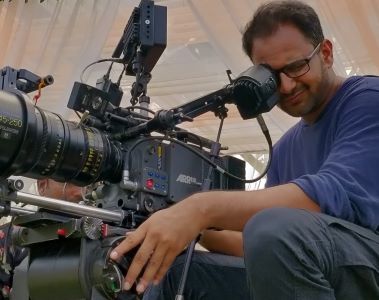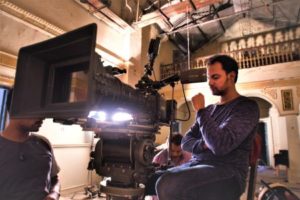‘Cinematographers are the most important support for directors’

Saurabh Tankha
When there are two national film awardees at home and you want to make a career in movies, life seems sorted. But not when you are born to renowned Oriya editor-director Gadadhar and writer-producer Padmini Puty. “Since I knew the people I had to chase to get work when I wanted to work in films, I managed doing so. To get the first project, it was of some help but only after chasing Anil Mehta (famous cinematographer) sir for a long time and constantly pestering him to give me an opportunity before he let me be a part of the crew of Wake Up Sid,” says Piyush Puty who has shot the national award-winning documentary Amdavad Ma Famous followed by Red Chillies’ Kaamyaab and multiple commercials. But then, says ace cinematographer Piyush, he had no work for 18 months. Later, Piyush went on to work with Excel Entertainment on Don 2 and briefly on Dharma Productions’ Agneepath before giving 19 months on Phantom’s Lootera where Vikramaditya Motwane and Ishika Mohan Motwane pushed to him to get behind the camera to start shooting. He ended up making the BTS/Documentary on the making of Lootera.
Know more about Piyush’s period of struggle which was followed by success, all due to his hard work and dedication through this interview…
Let us know more about the documentary, Amdavad Ma Famous and your association with Hardik Mehta.
It was in 2014 that Hardik and I decided to head to Old Ahmedabad to shoot some visuals and make a video of some kind to explore our capabilities as filmmakers. Apart from some great , we chased this young boy who gave a good energetic narrative to the documentary. It shaped up to be a 30-minute long crisp fun-filled documentary that was loved by everyone winning at Budapest, Al Jazeera, Hot Docs, MIFF 2016 and National Film Awards as the best non-feature film. It was later streamed on Netflix worldwide from 2016-2019.
How does it work when two creative people join hands? What kind of situations arise?
When two creative heads combine, they always jam with two different perspective towards the same subject. It’s always best for the final product. For example, the opening of Amdavad Ma Famous. It’s shot on a wide angle lens, close to the subject, followed the kid through real traffic to give the audience what it actually feels being the kid. Hardik was never so keen on shooting wide angle with go pro, it took me a while to convince him. But finally the way he has used the only wide angle shot sequence in the film, makes the film more effective.
How important is the role of a cinematographer in the making of a movie/ documentary?
I believe cinematographers are the most important support for directors, in bringing their imagination to life. To design a visual narrative and create imagery that brings the right essence of the script, the cinematographer plays a very important role in the making of a film. They need to give the right solutions for on set creative blockages.
What made you choose decide on being cinematographer?
I believe my love for images, capturing portraits and my fascination towards the world of visual narration dragged me towards cinematography.
Did you get inspired by someone to take up cinematography?
As a young boy during school days, Binod Pradan sir and Anil Mehta sir were my favourite cinematographers. Binod sir’s Devdas and Rang De Basanti, Anil sir’s Lagaan were the films which encouraged me a lot towards this technical side of film making. My father’s close friend from FTII, cinematographer Jugal Debata taught me so much about photography and art, approach and having an eye for every element.
Was it a planned move to graduate in physics to understand optics better which, in turn, would be useful in making movies?
Well yes, to understand optics and to get through FTII Cinematography Entrance test which I never got through. But eventually it helped me later. All technical calculations are instincts now.
Tell us more about your parents, their respective film careers.
My father is an FTII alumnus and works in Odisha film industry as director and editor. He has won multiple state film awards as director and editor, and national film award as best regional film director in 2008. His choice of films always gave me an exposure of films that were less accessible back then. So my upbringing happened with films of good taste and from all over the world. My mother has always worked with my father as a writer. She did the FA course from FTII/ NFAI in 1992. She was the producer of my father’s last feature film which won the National Film Award. So she’s a national film award winner.
How was the period of struggle?
The real struggle happened after my first project in 2009. Then I was on my own, chasing people again, to get the right work, with the right people. I ended up with no work for 18 months after Wake Up Sid before ending up on Don 2 shoot in 2011. Those 18 months were the toughest, to be constantly motivated and remain hopeful of good projects. Mumbai is expensive and ruthless at the same time, so you have to battle it out on your own.
How helpful was the film appreciation course from FTII?
The Film Appreciation course changed the way I saw films, the way I experienced cinema. It got me in touch with people and faculty where we ate, drank and slept cinema. Our classes used to start at nine in the morning and ended at five in the evening which was followed by screening of two films. So, for a month, it was living cinema.
The word “creative” to you means…
Beyond reality and thoughts.
Favourite filmmaker of all times
Alejandro González Iñárritu (Amores Perros, Babel, 21 Grams, The Revenant)
Favourite movie of all times
Rang De Basanti, La La Land



